-

新人教版高中英语必修3Unit 3 Diverse Cultures-Listening &Speaking&Talking教学设计
1. In Picture 1 and Picture 2, where do you think they are from? How do you know?From their wearings, we can know they are from ethnic minority of China--- Miao and Dong.Picture 1, they are playing their traditional instrument lusheng in their traditional costumes.Picture 2. the girls are Miao because they wear their traditional costumes and silver accessory.2. In Picture 3, can you find which village it is? What time is it in the picture?It is Dong village. It is at night. Step 2 While-listeningJustin met a new friend while traveling in Guizhou. Listen to their conversation and complete the summaries below.Part 1Justin and Wu Yue watched some Miao people play the lusheng. The instrument has a history of over 3,000 years and it is even mentioned in the oldest collection of Chinese poetry. Then they watched the lusheng dance. Justin wanted to buy some hand-made silver/traditional accessories as souvenirs. He was told that the price will depend on the percentage of silver. Part 2They will go to a pretty Dong minority village called Zhaoxing. they will see the drum towers and the wind and rain bridges. They may also see a performance of the Grand Song of the Dong people.Step 3 Post-listening---TalkingWork in groups. Imagine Justin is telling some friends about his trip to Guizhou. One of you is Justin and the rest of you are his friends. Ask Justin questions about his trip and experience. The following expressions may help you.

新人教版高中英语必修3Unit 4 Space Exploration-Discovering Useful Structure教学设计
The theme of the section is “Describe space facts and efforts to explore space”. Infinitives are one of non-finite verbs, as the subjects, objects, predicative, attributes and adverbials. This unit is about space exploration, which is a significant scientific activity, so every scientific activity has strong planning. Therefore, using the infinitives to show its purpose, explanations or restrictions is the best choice.1. Learn the structure, functions and features of infinitives.2. Learn to summarize some rules about infinitives to show purpose and modify.3. Learn to use infinitives in oral and writing English. 1. Learn the structure, functions and features of infinitives.2. Learn to summarize some rules about infinitives to show purpose and modify.3. Learn to use use infinitives in oral and writing English.Step 1 Lead in---Pair workLook at the following sentences and focus on the italicized infinitives. In pairs, discuss their functions. 1. I trained for a long time to fly airplanes as a fighter pilot..(作目的状语)2. As we all know, an astronaut needs to be healthy and calm in order to work in space..(作目的状语)3. First of all, you must be intelligent enough to get a related college degree..(作目的状语)4. Some scientist were determined to help humans realise their dream to explore space..(作定语)5. On 12 April 1961, Yuri Gagarin became the first person in the world to go into space..(作定语)Summary:1. 不定式的结构:to+do原形。2. 分析上面的句子,我们知道在描述太空探索时,动词不定式不仅可以用来表目的,还可以用来作定语,表修饰。

新人教版高中英语必修3Unit 4 Space Exploration-Listening&Speaking&Talking教学设计二
The themes of this part are “Talk about how to become an astronaut” and “Talk about life in space”. As Neil Armstrong said “Mystery creates wonder and wonder is the basis of man’s desire to understand. Space is difficult for human to reach, therefore, humans are full of wonders about it. However, if wanting to achieve the dream of reaching the Moon, some of our human should work hard to be an astronaut at first. Part A(Talk about how to become an astronaut) is a radio interview in a radio studio, where the host asked the Chinese astronauts about his story how to become an astronaut. Yang Liwei told his dreamed to be an astronaut since childhood. Then he worked hard to get into college at 22. The next 10 years, he gradually became an experienced pilot. At the same time, to be an astronaut, he had to study hard English, science and astronomy and trained hard to keep in good physical and mental health and to practise using space equipment. Part B (Talk about life in space) is also an interview with the astronaut Brown, who is back on the earth. The host Max asked about his space life, such as his emotion about going back the earth, the eating, shower, brushing, hobbies and his work. Part A and Part B are interviews. So expressing curiosity about the guests’ past life is a communicative skill, which students should be guided to learn.1. Students can get detailed information about how Yang Liwei became an astronaut and Max’s space life.2. Students learn to proper listening strategy to get detailed information---listening for numbers and taking notes.3. Students can learn related sentences or phrases to express their curiosity like “ I wish to know...” “I’d love to know...”4. Students can learn more about the space and astronauts, even be interested in working hard to be an astronaut
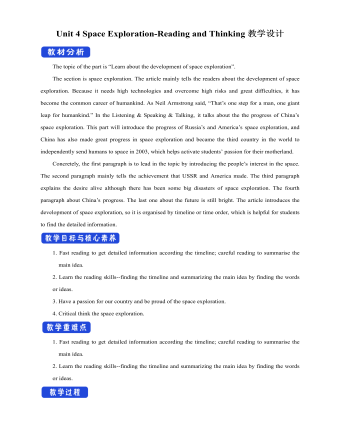
新人教版高中英语必修3Unit 4 Space Exploration-Reading and Thinking教学设计一
Q4: What is the function of the International exploration ?Having astronauts from different countries on boardQ5: What can you learn from Para 4 ?China has made great achievements in exploring spaceQ6: What is the attitude to the space exploration ?SupportiveStep 6 Post reading---RetellPeople have always wanted to learn more about space. Before the mid-20th century, most people felt (1)_________ (travel) into space was an impossible dream. However, (2)____ the help of scientists, peoplesucceeded in realizing their dream (3) _________ (explore) space. On 4 October 1957, the Sputnik 1 satellite (4) ____________(launch) by the USSR. (5) ________________ scientists try to make sure nothing goes wrong, accidents can still happen. These disasters made everyone(6)___________(disappoint), but people still believe in the importance of (7) ________(carry) on space exploration. In 2003, China became the third country to (8)_____________ (independent) send humans into space. Then Shenzhou 6 and 7 completed (9)____ second manned orbit and the first Chinese spacewalk. In spite of the difficulties, scientists hope future (10)__________ (discovery) will not only enable us to understand the universe but also help us survive well into the future.Answers: 1. travelling 2. with 3. to explore 4. was launched 5. Although6. disappointed 7. carrying 8. independently 9. a 10. discoveriesStep 6 Post reading---Critical thinkingQ1: What do you think of the space exploration ? I think it is beneficial to us. Through further study of space, people will make full use of it in the future, such as the space experiments by Wang Yaping in Tian Gong 1.Q2: If you are determined to be an astronaut, what should you prepare at present ?First of all, I should study hard to get a related college degree. Besides, I must keep mental and physical healthy.Step 7. HomeworkTry to summarize the structure of the article by a mind map.
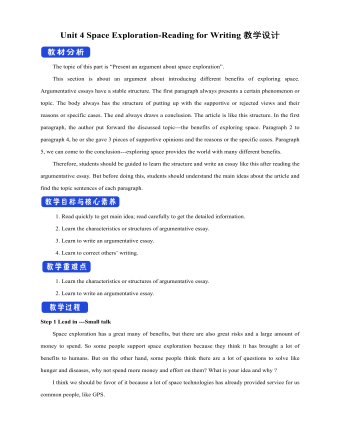
新人教版高中英语必修3Unit 4 Space Exploration-Reading for Writing教学设计二
⑦在我看来, 探索太空是值得的。As far as I am concerned, it is worthwhile to explore the space.Step 10 Writing---draftRecently, students in our class have had heated a discussion on whether space is worth exploring. Students hold different ideas about it.30% of us think space exploration is not worthwhile. They think space is too far away from us and our daily life and is a waste of money. And the money spent on space exploration can be used to solve the earth’s problems such as starvation and pollution.On the other hand,70% think space is worth exploring because we have benefited a lot from it,such as using satellites for communication and weather forecast. What’s more,with further space research,we may solve the population problem by moving to other planets one day. Also,space research will enable us to find new sources to solve the problem of energy shortages on the earth.As far as I am concerned, it is worthwhile to explore the space. Not only can it promote the development of society but also enrich our life. Step 11 Pair workExchange drafts with a partner. Use this checklist to help your partner revise his/her draft.1.Does the writer explain why he/she changed/wanted to change?2.Does the writer tell how the changes have improved or will improve his/her life?3.Is the text well-organised?4.Does the writer use words and expressions to show similarities and differences?5.Are there any grammar or spelling errors?6.Does the writer use correct punctuation?

新人教版高中英语必修3Unit 4 Space Exploration-Reading For Writing教学设计一
另一方面,其余的人反对这个计划,因为它可能会导致一些不好的影响。7.I hold the belief that space exploration not only enable us to understand how the universe began but also help us survived well into the future.我坚信探索太空不仅能够使我们了解宇宙的起源而且能够帮助我们更好地走进未来。8.I think we should spend more time and money exploring space so as to provide new and better solutions to people's shortterm and longterm problems.为了给人类的短期和长期问题提供更新和更好的解决方法,我认为我们应该花更多的时间和金钱来探索太空。9.From my point of view,it is wrong of young people to depend on their telephones too much,which may do harm to both their physical and mental health.在我看来,年轻人过度依赖手机是不对的,因为它们可能会对他们的身心健康都有害。最近你班同学就“人类是否应该进行宇宙探索”这个问题进行了激烈的讨论。有人认为,探索宇宙不仅让人类更好地了解宇宙的发展,还可以用来指导农业生产,以及把一些探索太空的高新技术用于现实生活;也有一些人认为探索太空花掉了大量的人力物力;影响了人们的生活水平。请你根据以下情况写一篇报告并发表自己的观点。注意:1.写作内容应包括以上全部要点,可适当发挥,使上下文连贯;

新人教版高中英语选修2Unit 4 Journey Across a Vast Land教学设计
当孩子们由父母陪同时,他们才被允许进入这个运动场。3.过去分词(短语)作状语时的几种特殊情况(1)过去分词(短语)在句中作时间、条件、原因、让步状语时,相当于对应的时间、条件、原因及让步状语从句。Seen from the top of the mountain (=When it is seen from the top of the mountain), the whole town looks more beautiful.从山顶上看,整个城市看起来更美了。Given ten more minutes (=If we are given ten more minutes), we will finish the work perfectly.如果多给十分钟,我们会完美地完成这项工作。Greatly touched by his words (=Because she was greatly touched by his words), she was full of tears.由于被他的话深深地感动,她满眼泪花。Warned of the storm (=Though they were warned of the storm), the farmers were still working on the farm.尽管被警告了风暴的到来,但农民们仍在农场干活。(2)过去分词(短语)在句中作伴随、方式等状语时,可改为句子的并列谓语或改为并列分句。The teacher came into the room, followed by two students (=and was followed by two students).后面跟着两个学生,老师走进了房间。He spent the whole afternoon, accompanied by his mom(=and was accompanied by his mom).他由母亲陪着度过了一整个下午。

新人教版高中英语选修2Unit 1 Science and Scientists-Learning about Language教学设计
Step 7: complete the discourse according to the grammar rules.Cholera used to be one of the most 1.__________ (fear) diseases in the world. In the early 19th century, _2_________ an outbreak of cholera hit Europe, millions of people died. But neither its cause, 3__________ its cure was understood. A British doctor, John Snow, wanted to solve the problem and he knew that cholera would not be controlled _4_________ its cause was found. In general, there were two contradictory theories 5 __________ explained how cholera spread. The first suggested that bad air caused the disease. The second was that cholera was caused by an _6_________(infect) from germs in food or water. John Snow thought that the second theory was correct but he needed proof. So when another outbreak of cholera hit London in 1854, he began to investigate. Later, with all the evidence he _7_________ (gather), John Snow was able to announce that the pump water carried cholera germs. Therefore, he had the handle of the pump _8_________ (remove) so that it couldn't be used. Through his intervention,the disease was stopped in its tracks. What is more, John Snow found that some companies sold water from the River Thames that __9__________________ (pollute) by raw waste. The people who drank this water were much more likely _10_________ (get) cholera than those who drank pure or boiled water. Through John Snow's efforts, the _11_________ (threaten) of cholera around the world saw a substantial increase. Keys: 1.feared 2.when 3. nor 4.unless 5.that/which 6.infection 7.had gathered 8.removed 9.was polluted 10.to get 11. threat

新人教版高中英语选修2Unit 1 Science and Scientists-Discovering useful structures教学设计
The grammatical structure of this unit is predicative clause. Like object clause and subject clause, predicative clause is one of Nominal Clauses. The leading words of predicative clauses are that, what, how, what, where, as if, because, etc.The design of teaching activities aims to guide students to perceive the structural features of predicative clauses and think about their ideographic functions. Beyond that, students should be guided to use this grammar in the context apporpriately and flexibly.1. Enable the Ss to master the usage of the predicative clauses in this unit.2. Enable the Ss to use the predicative patterns flexibly.3. Train the Ss to apply some skills by doing the relevant exercises.1.Guide students to perceive the structural features of predicative clauses and think about their ideographic functions.2.Strengthen students' ability of using predicative clauses in context, but also cultivate their ability of text analysis and logical reasoning competence.Step1: Underline all the examples in the reading passage, where noun clauses are used as the predicative. Then state their meaning and functions.1) One theory was that bad air caused the disease.2) Another theory was that cholera was caused by an infection from germs in food or water.3) The truth was that the water from the Broad Street had been infected by waste.Sum up the rules of grammar:1. 以上黑体部分在句中作表语。2. 句1、2、3中的that在从句中不作成分,只起连接作用。 Step2: Review the basic components of predicative clauses1.Definition

新人教版高中英语选修2Unit 1 Science and Scientists-Reading and thinking教学设计
Step 5: After learning the text, discuss with your peers about the following questions:1.John Snow believed Idea 2 was right. How did he finally prove it?2. Do you think John Snow would have solved this problem without the map?3. Cholera is a 19th century disease. What disease do you think is similar to cholera today?SARS and Covid-19 because they are both deadly and fatally infectious, have an unknown cause and need serious public health care to solve them urgently.keys:1. John Snow finally proved his idea because he found an outbreak that was clearly related to cholera, collected information and was able to tie cases outside the area to the polluted water.2. No. The map helped John Snow organize his ideas. He was able to identify those households that had had many deaths and check their water-drinking habits. He identified those houses that had had no deaths and surveyed their drinking habits. The evidence clearly pointed to the polluted water being the cause.3. SARS and Covid-19 because they are both deadly and fatally infectious, have an unknown cause and need serious public health care to solve them urgently.Step 6: Consolidate what you have learned by filling in the blanks:John Snow was a well-known _1___ in London in the _2__ century. He wanted to find the _3_____ of cholera in order to help people ___4_____ it. In 1854 when a cholera __5__ London, he began to gather information. He ___6__ on a map ___7___ all the dead people had lived and he found that many people who had ___8____ (drink) the dirty water from the __9____ died. So he decided that the polluted water ___10____ cholera. He suggested that the ___11__ of all water supplies should be _12______ and new methods of dealing with ____13___ water be found. Finally, “King Cholera” was __14_____.Keys: 1. doctor 2. 19th 3.cause 4.infected with 5.hit 6.marked 7.where 8.drunk 9.pump 10.carried 11.source 12.examined 13.polluted 14.defeatedHomework: Retell the text after class and preview its language points
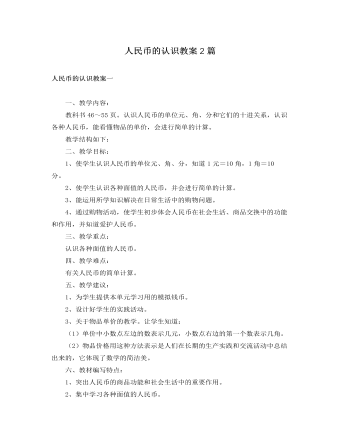
人教版新课标小学数学一年级下册人民币的认识教案2篇
出示例6挂图。教师试问:谁知道0.50元是几角?2.00元是几角?你是怎么知道?以元为单位小数点左边是几就是几元,右边第一位是几就是几角,右边第二位是几就是几分。1.20元是1元2角。35.90元是35元9角。(这部分知识学生知道它表示几元几角就可以了,至于1.20元是个什么数,怎么读、写不需要学生掌握)3、教学例7。(1) 课件演示例7第一小题。教师:0.5元是几角?(5角)0.80元是几角?(8角)学生回答。5角+8角是几角?(5角+8角=13角教师板书)教师问:多少角是1元?13角里面拿出10角还剩多少角?(3角)所以13角等于1元3角。教师板书:5角+8角=13角=1元3角。(2)例7第二小题(课件演示,提出问题:我买这两个气球要多少钱)学生尝试完成,然后提问:你是怎么想的?教师强调:元、角计算,只有在相同单位的情况下,才能相加。
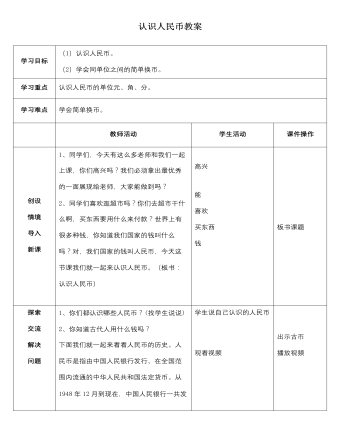
人教版新课标小学数学一年级下册认识人民币教案
教师活动创设情境导入新课 1、 同学们,今天有这么多老师和我们一起上课,你们高兴吗?我们必须拿出最优秀的一面展现给老师,大家能做到吗?2、同学们喜欢逛超市吗?你们去超市干什么啊,买东西要用什么来付款?世界上有很多种钱,你知道我们国家的钱叫什么吗?对,我们国家的钱叫人民币,今天这节课我们就一起来认识人民币。(板书:认识人民币)探索交流解决问题1、 你们都认识哪些人民币?(找学生说说)2、 你知道古代人用什么钱吗?下面我们就一起来看看人民币的历史。人民币是指由中国人民银行发行、在全国范围内流通的中华人民共和国法定货币。从1948年12月到现在,中国人民银行一共发行了五套人民币。分别是:1948年12月1日发行的第一套人民币;1955年3月1日发行的第二套人民币;1962年4月15日发行的第三套人民币;1987年4月27日发行的第四套人民币。还有1999年10月1日发行的第五套人民币也就是目前市场上流通的人民币。 请同学们仔细观察,这些钱你们都认识吗?(屏幕显示)人民币上有什么?(国徽)国徽是我们国家的标志,许多人民币上都有国徽,所以我们应该爱护它,不要故意损坏它。瞧,我们国家的人民币有这么多呢!有些是纸做的,叫纸币,(课件突出显示纸币)有的是金属做的,叫硬币。(课件突出显示硬币)2、特征辨认。师:这些人民币你们都认识吗?3、 师:那好,老师来考考你们这张人民币的面值是多少?你是怎么知道的?(同学们观察的真仔细)4、 看下面几张你都认识吗?5、 同学们学的真认真,老师中午回家要乘坐无人售票车,这种车要求自觉投币1元而不找零钱,老师只有一张10元的人民币,老师该怎么办哪?6、谁能帮老师换换钱?
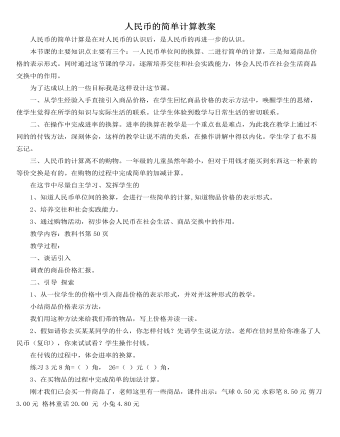
人教版新课标小学数学一年级下册人民币的简单计算教案
人民币的简单计算是在对人民币的认识后,是人民币的再进一步的认识。本节课的主要知识点主要有三个:一人民币单位间的换算、二进行简单的计算,三是知道商品价格的表示形式。同时通过这节课的学习,逐渐培养交往和社会实践能力,体会人民币在社会生活商品交换中的作用。为了达成以上的一些目标我是这样设计这节课。一、从学生经验入手直接引入商品价格,在学生回忆商品价格的表示方法中,唤醒学生的思绪,使学生觉得在所学的知识与实际生活的联系。让学生体验到数学与日常生活的密切联系。二、在操作中完成进率的换算。进率的换算在教学是一个重点也是难点,为此我在教学上通过不同的的付钱方法,深刻体会,这样的教学让说不清的关系,在操作讲解中得以内化。学生学了也不易忘记。
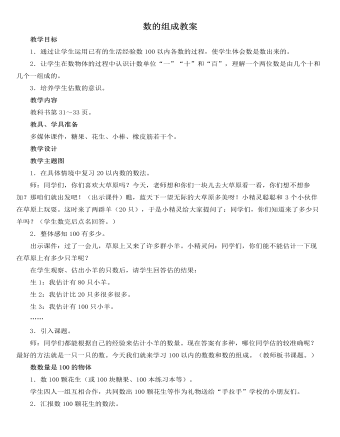
人教版新课标小学数学一年级下册数的组成教案
3.让学生同桌合作,一人任意说出两位数,另一个人说说它是由几个十、几个一组成的?然后互换。4.完成例3下面的“做一做”,之后请学生汇报汇报。课堂作业做练习七第二题。1.课件出示“百球图”。先让学生整体观察,然后估一估,“有多少个球?”2.在学生估测的基础上引导学生数数。用小精灵聪聪的话问:“怎样数比较快?”然后点名让学生在班上交流自己数的方法。3.引导学生将数出的准确数100与自己估测的数对比。检验自己估的对不对,表扬估对的同学。小结组织学生小结:让学生用自己的话说一说本节课学习的内容。在学生较凌乱叙述的基础上教师概括出本节课所学的知识。课后作业让学生课后数数主题图中小羊的只数,每数十只圈一下,看看到底有多少只羊,检验自己刚开始时估的对不对?
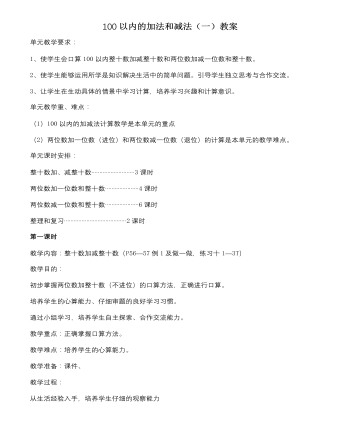
人教版新课标小学数学一年级下册100以内的加法和减法(一)教案
一、谈话引入,激发学生学习兴趣师:六一快到了,很多小朋友都想了很多的方式来庆祝,有的小朋友想去公园,有的小朋友想用自己攒的零花钱去买玩具呢,我们也和他们一起去看看吧!(电脑出示玩具店的货架和玩具的标价。)二、自主探索,提出问题。1、仔细看图,提出问题师:看货架上都有哪些玩具?你喜欢什么玩具?你从图上知道了哪些信息?(观察后指名回答。)课件出示:两个小朋友的对话师:货架下的两个小朋友在说什么?你知道了什么信息?(指明生说出题意)师:怎样才知道左边的小朋友买大象玩具后还剩多少元?右边的小朋友还差多少元呢?(用减法算)师:你知道这么列式吗?(师根据生回答板书算式)师:大家会算上面的算式吗?先在小组里摆一摆,算一算。2、分组操作,形成思维。学生摆小棒,教师巡回指导学生操作。3、信息反馈,抽象算法。师:大家摆出了上面两道题的得数吗?谁来说一说是怎样摆的?
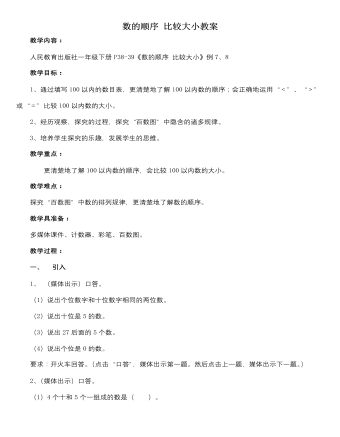
人教版新课标小学数学一年级下册数的顺序 比较大小教案
探究二:100以内数的大小比较。1、 (媒体出示课本第39页例8鸡蛋图。)师:看这鸡蛋图,谁知道哪边的鸡蛋多一些?你是怎么比较的?(学生可能回答:(1)根据鸡蛋图比较。(2)根据数的顺序比较。(3)根据数的组成比较。)(根据学生回答,点击○媒体出示答案。)2、 师:刚才我们看着鸡蛋图比较了两个数的大小,那如果没有图,我们会不会直接比较两个数的大小呢?我们请计数器来帮忙,谁来拨?(媒体出示计数器)师:谁能来说说每个数位上数的意义,再进行比较,说说比较的方法。(学生已经有了比较20以内数的大小的基础,教师引导学生在此基础上说出:28是由2个十和8个一组成,26是2个十和6个一组成,所以28>26;或者根据数数时28在26后面,所以28>26。)(点击表示28的计算器图,媒体出示28是由2个十和8个一组成;点击表示26的计算器图,媒体出示:26是由2个十和6个一组成;点击“26是由2个十和6个一组成”,媒体出示:28>26。)(师板书:28>26)
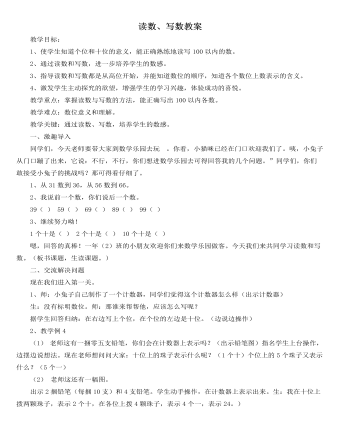
人教版新课标小学数学一年级下册读数、写数教案
教学目标:1、使学生知道个位和十位的意义,能正确熟练地读写100以内的数。2、通过读数和写数,进一步培养学生的数感。3、指导读数和写数都是从高位开始,并能知道数位的顺序,知道各个数位上数表示的含义。4、激发学生主动探究的欲望,增强学生的学习兴趣,体验成功的喜悦。教学重点:掌握读数与写数的方法,能正确写出100以内各数。教学难点:数位意义和理解。教学关键:通过读数、写数,培养学生的数感。一、激趣导入同学们,今天老师要带大家到数学乐园去玩 。你看,小猫咪已经在门口欢迎我们了。咦,小兔子从门口蹦了出来,它说:不行,不行,你们想进数学乐园去可得回答我的几个问题。”同学们,你们敢接受小兔子的挑战吗?那可得看仔细了。1、从31数到36,从56数到66。2、我说前一个数,你们说后一个数。
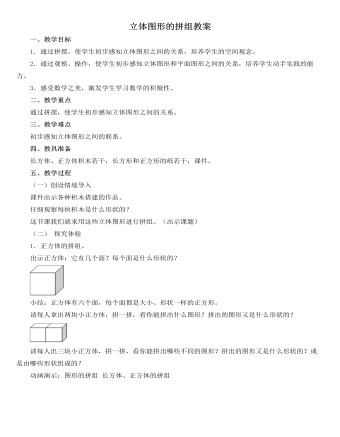
人教版新课标小学数学一年级下册立体图形的拼组教案
小结:分别沿正方形纸的两组对边做出的圆筒一样长、也一样粗,因为正方形的四条边都相等。解决问题。课件出示:你能用几种方法,数出下图中小正方体的个数?方法一:可以从上往下数(或从下往上数)第一层有2个,第二层有4个,第三层有6个,三层共有:2 + 4 + 6 = 12(个);方法二:也可以从左往右数(或从右往左数)。第一排有4个,第二排有6个,第三排有2个,三排共有:4 + 6 + 2 = 12(个);方法三:还可以将最上面一层的2个移到第二层的右侧。这样,这堆木块就变成了两层,每层都有6个,共有6 + 6 = 12(个)。(四)全课总结这节课我们用长方体和正方体拼组了很多不同形状的图形。其实在我们的生活中,有很多物体的形状都是由长方体和正方体拼组而成的,希望同学们课下留心观察。(五)练习数一数,下面的图形由几个正方体组成?
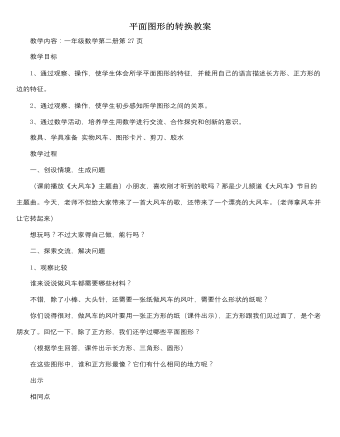
人教版新课标小学数学一年级下册平面图形的转换教案
教学目标1、通过观察、操作,使学生体会所学平面图形的特征,并能用自己的语言描述长方形、正方形的边的特征。2、通过观察、操作,使学生初步感知所学图形之间的关系。3、通过数学活动,培养学生用数学进行交流、合作探究和创新的意识。教具、学具准备 实物风车、图形卡片、剪刀、胶水教学过程一、创设情境,生成问题(课前播放《大风车》主题曲)小朋友,喜欢刚才听到的歌吗?那是少儿频道《大风车》节目的主题曲。今天,老师不但给大家带来了一首大风车的歌,还带来了一个漂亮的大风车。(老师拿风车并让它转起来)想玩吗?不过大家得自己做,能行吗?二、探索交流,解决问题1、观察比较谁来说说做风车都需要哪些材料?不错,除了小棒、大头针,还需要一张纸做风车的风叶,需要什么形状的纸呢?你们说得很对,做风车的风叶要用一张正方形的纸(课件出示),正方形跟我们见过面了,是个老朋友了。回忆一下,除了正方形,我们还学过哪些平面图形?
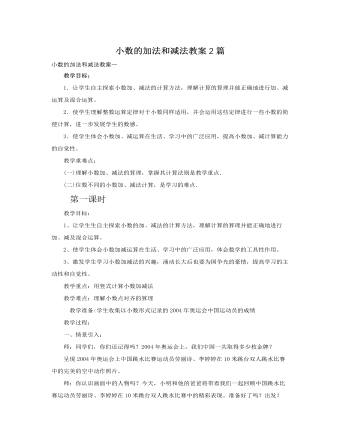
人教版新课标小学数学四年级下册小数的加法和减法教案2篇
教学目标:1.让学生自主探索小数加、减法的计算方法,理解计算的算理并能正确地进行加、减运算及混合运算。2.使学生理解整数运算定律对于小数同样适用,并会运用这些定律进行一些小数的简便计算,进一步发展学生的数感。3.使学生体会小数加、减运算在生活、学习中的广泛应用,提高小数加、减计算能力的自觉性。教学重难点:(一)理解小数加、减法的算理,掌握其计算法则是教学重点.(二)位数不同的小数加、减法计算,是学习的难点.第一课时教学目标:1、让学生生自主探索小数的加、减法的计算方法,理解计算的算理并能正确地进行加、减及混合运算。2、使学生体会小数加减运算在生活、学习中的广泛应用,体会数学的工具性作用。3、激发学生学习小数加减法的兴趣,涌动长大后也要为国争光的豪情,提高学习的主动性和自觉性。